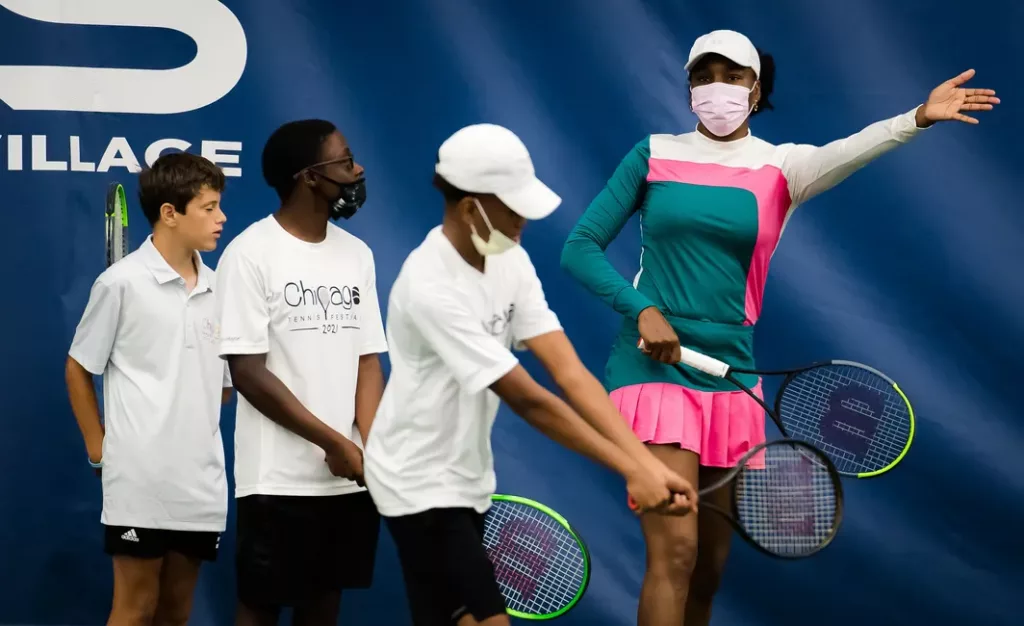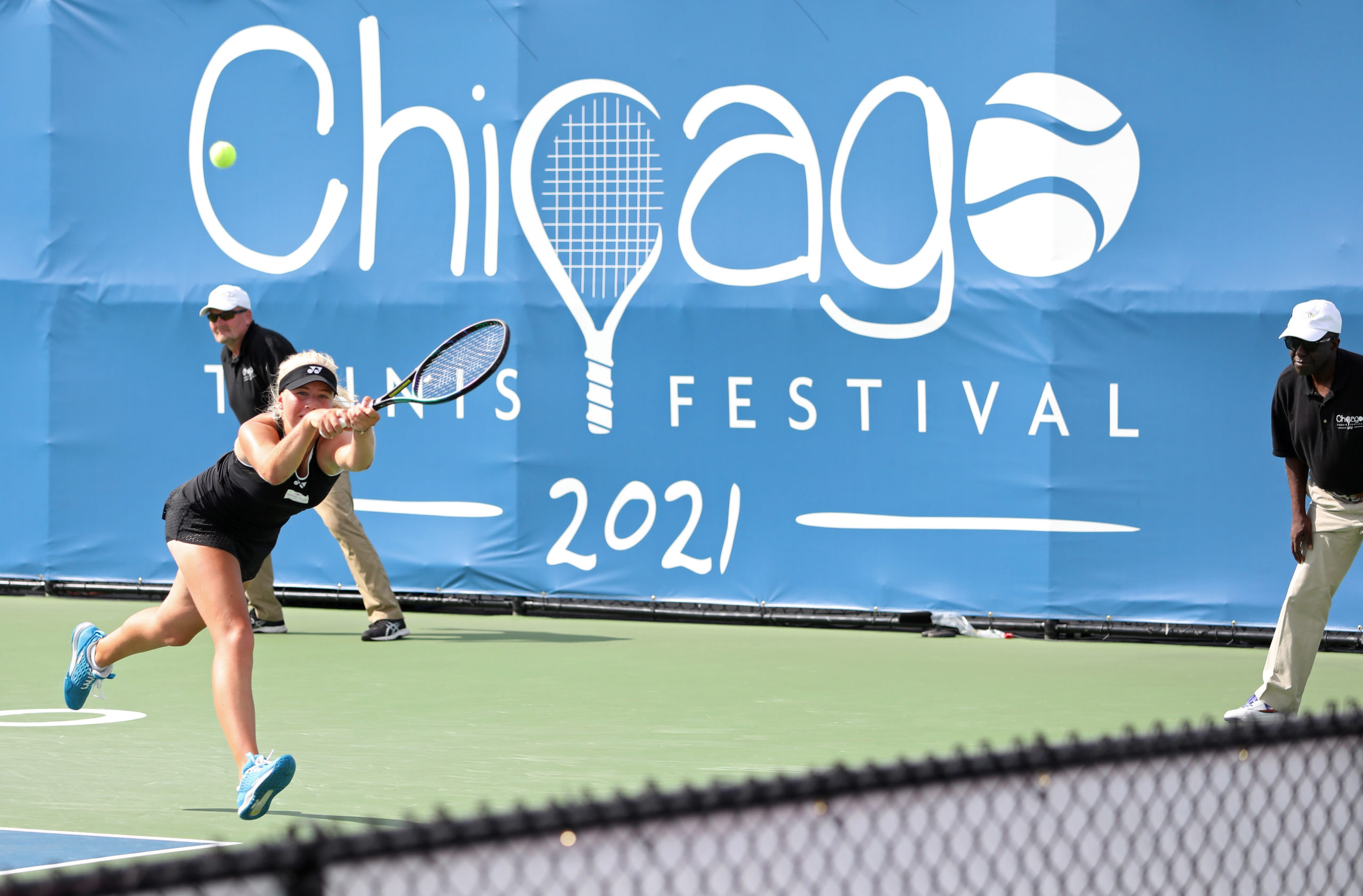Hey, everyone! There’s a world class women’s tennis tournament taking place on the South Side. Right now. All three of this summer’s Olympic singles medalists — Belinda Bencic of Switzerland, Markéta Vondroušová of the Czech Republic, and Elina Svitolina of Ukraine — have volleyed their way into the quarterfinals of the Chicago Fall Tennis Classic, which concludes Sunday, with a $50,130 prize for the winner.
The Fall Tennis Classic is the third and most prestigious of three events in the Chicago Tennis Festival, which has brought elite women’s tennis back to Chicago after a nearly 25-year absence. Not since the Ameritech Cup, won 12 times by Martina Navratilova, but last held in 1997, has the city seen this kind of talent.
Professional omen’s tennis came back to Chicago because it had a place to come to: the XS Tennis and Education Foundation, a 13-acre campus with 15 outdoor courts, both hard and clay, and 12 indoor courts. Located at 53rd and State, in the Washington Park neighborhood, it’s the creation of Kamau Murray, a South Shore native, former collegiate player, and tennis coach.
Murray started playing tennis when he was seven years old, because a tennis camp at 87th and Jeffery was the only summer recreational activity his parents could find for him. It wasn’t a popular sport in South Shore.
“In that neighborhood, Black kids didn’t want to play tennis,” Murray said. “Black people historically have not played tennis. Black and Jewish people were not allowed to join tennis clubs. I did not want to play. There was nobody to play who looked like me, except Arthur Ashe.”
Murray thrived in tennis, though. He played at Whitney Young, then Florida A&M University. After graduation, he worked in pharmaceutical sales, and coached Sloane Stephens, a world-class player from Florida who won the 2017 U.S. Open. (Stephens lost in the first round of the Fall Tennis Classic.) His ambition was always to create a “Black mecca” for tennis on the South Side. When Murray started XS Tennis in 2005, he coached players at Dunbar Park in the summer, and the National Guard Armory at 51st and Cottage Grove in the winter.
XS Tennis opened its current, $16.9 million facility in 2018, on the site of the Robert Taylor Homes — the South Side had the space Murray needed. Every year now, 2,300 young people play tennis at XS. A wall inside the building displays photos of XS alumni who have gone on to play in college: Purdue, Harvard, Michigan, Grambling. Tennis is much more popular on the South Side than it was when Murray was growing up. Black kids have more role models, especially the Williams sisters, Venus and Serena, who have won 33 Grand Slam singles titles between them.
“The Williams sisters definitely lit a fire,” Murray said.
Venus Williams visited XS Tennis in August to play in the Chicago Women’s Open, the second of the Festival’s three events. After losing in the first round, she stuck around to hold a clinic for 50 young players.

XS Tennis’s biggest supporter is arguably the most famous women’s tennis player of all: Billie Jean King, one of the founders of the Women’s Tennis Association. King, who maintains a home in Chicago, has become a close friend and ally of Murray’s, once telling the Sun-Times that “everyone in Chicago should be proud of Kamau.” King helped raise funds for the XS campus, and bring a pro tournament there.
“Billie Jean King is one of my mentors, and this relationship is one that I cherish,” Murray said. “It’s played a formative part in my career and personal growth. Through this long-standing relationship, coupled with what we at XS Tennis do in the community, as far as exposing this elite sport to underserved communities, we collectively came together to bring these pro-level tournaments back to Chicago. By doing so, the WTA and XS Tennis are showing kids, specifically Black kids from the south side of Chicago, that success in the tennis industry is a possibility for them.”
There weren’t a whole lot of people watching Thursday’s round-of-16 matches at the Fall Tennis Classic. As a result, it was possible for fans who’d paid $75 for a day’s admission to get really close to the action. Steff Du Bois, a women’s tennis superfan in Elton John glasses and yellow sneakers, was one of 30 or so spectators sitting on aluminum bleachers beside one of the satellite courts to watch a match between Elena Rybakina of Kazakhstan and Veronica Kudermetova of Russia. (Rybakina won, 7-6, 7-5.) He snagged an errant ball off Rybakina’s racket. Although he was asked to throw it back, after the match ended, he got Rybakina’s autograph on a shawl.
“I’m the biggest fan of women’s tennis, so this is really a dream,” Du Bois said. “This is the biggest run of women’s tennis in decades [in Chicago]. Men’s tennis for me is a little too pound-pound brute force. The women work other elements into the game — more topspin, more movement. The women’s game is more competitive at the top, too. Men’s tennis is just three guys. Anyone can win a women’s tournament.”
Du Bois was thrilled with himself for catching the ball — “I always dreamed that I would perform well under that pressure, and I did” — and he was thrilled with where he was watching tennis, too.
“The site is perfectly sized,” he said. “It’s navigable. Also, it gets people to the South Side and increases tennis on the South Side. In terms of full tennis sites, this is the best.”




